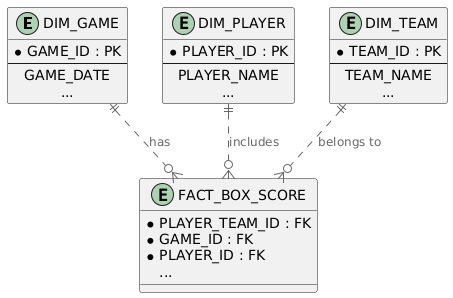NBA Dataset Table Design Tutorial
Introduction to the NBA and Its Data Ecosystem
The National Basketball Association (NBA) represents the pinnacle of professional basketball competition, comprising 30 franchises competing across North America. Each NBA season encompasses hundreds of games, generating a vast and diverse array of data points that capture player performance, game events, team dynamics, and season progression.
Typical Data Components in NBA Analytics
- Player Performance Metrics: Quantitative measures recorded at game granularity, including points scored, assists, rebounds, steals, blocks, turnovers, shooting percentages, and more.
- Game Metadata: Contextual information such as game date, venue, competing teams, final scores, and game outcomes.
- Player Profile Information: Descriptive attributes covering player demographics (name, age, height), positional roles, team affiliations, and career statistics.
- Team Characteristics: Organizational data including team names, home cities, coaching staff, and franchise histories.
Together, these datasets enable comprehensive analyses of individual and team performance trends, strategic evaluations, and predictive modeling.
Fundamental Table Design Principles for Analytical Workloads
When architecting tables for analytical databases or data warehouses, adherence to sound design principles is critical to ensure:
- Performance: Efficient query execution and minimal redundancy.
- Maintainability: Ease of updates, scalability, and data integrity.
- Usability: Clear, intuitive structures for business analysts and data scientists.
Designing a Star Schema for NBA Analytics: A Step-by-Step Approach
The star schema simplifies complex data relationships and accelerates analytical queries by segregating facts and dimensions.
1. Identify Fact and Dimension Entities
| Fact Table (Measurable Events) | Dimension Tables (Descriptive Attributes) |
|---|---|
| Statistics per game: points, assists, rebounds, steals, blocks, turnovers | Player information: player name, position, height, age, team |
| Game details: date, venue, participating teams, final scores | |
| Team details: team name, city, coach |
2. Define the Dimension and Fact Table:
FACT_BOX_SCOREDIM_GAMEDIM_PLAYERDIM_TEAM
The UML diagram for the above designed table can be summarized as

Summary and Best Practices
| Design Principle | Implementation in NBA Schema |
|---|---|
| Avoid excessively wide tables | Separate facts (stats) from descriptive dimensions |
| Avoid excessively narrow tables | Include necessary foreign keys and measures in fact |
| Logical grouping of data | Distinct dimension tables for players, games and teams. |
| Star schema modeling | Central fact table connected to multiple dimensions |